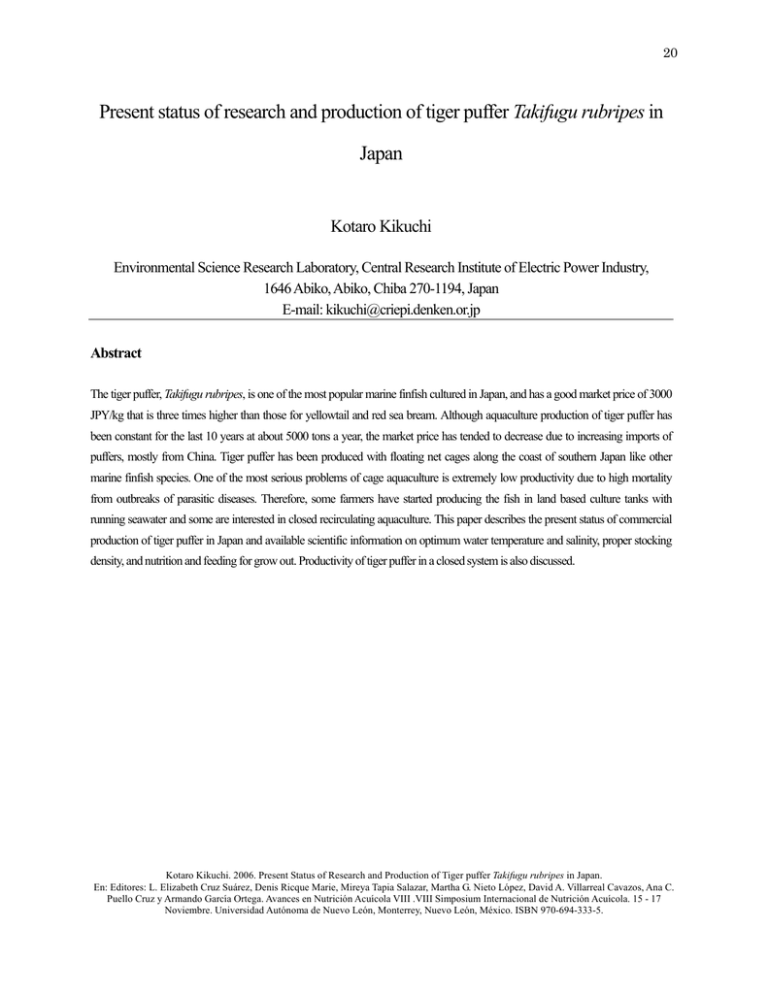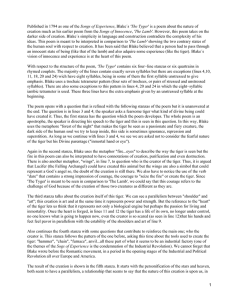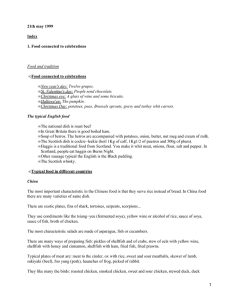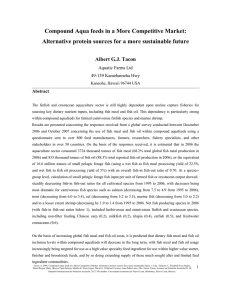Present status of research and production of tiger puffer Takifugu
Anuncio

20 Present status of research and production of tiger puffer Takifugu rubripes in Japan Kotaro Kikuchi Environmental Science Research Laboratory, Central Research Institute of Electric Power Industry, 1646 Abiko, Abiko, Chiba 270-1194, Japan E-mail: [email protected] Abstract The tiger puffer, Takifugu rubripes, is one of the most popular marine finfish cultured in Japan, and has a good market price of 3000 JPY/kg that is three times higher than those for yellowtail and red sea bream. Although aquaculture production of tiger puffer has been constant for the last 10 years at about 5000 tons a year, the market price has tended to decrease due to increasing imports of puffers, mostly from China. Tiger puffer has been produced with floating net cages along the coast of southern Japan like other marine finfish species. One of the most serious problems of cage aquaculture is extremely low productivity due to high mortality from outbreaks of parasitic diseases. Therefore, some farmers have started producing the fish in land based culture tanks with running seawater and some are interested in closed recirculating aquaculture. This paper describes the present status of commercial production of tiger puffer in Japan and available scientific information on optimum water temperature and salinity, proper stocking density, and nutrition and feeding for grow out. Productivity of tiger puffer in a closed system is also discussed. Kotaro Kikuchi. 2006. Present Status of Research and Production of Tiger puffer Takifugu rubripes in Japan. En: Editores: L. Elizabeth Cruz Suárez, Denis Ricque Marie, Mireya Tapia Salazar, Martha G. Nieto López, David A. Villarreal Cavazos, Ana C. Puello Cruz y Armando García Ortega. Avances en Nutrición Acuícola VIII .VIII Simposium Internacional de Nutrición Acuícola. 15 - 17 Noviembre. Universidad Autónoma de Nuevo León, Monterrey, Nuevo León, México. ISBN 970-694-333-5. 21 Introduction There are more than 15 puffer species in Japan and the total wild catch has been rather stable ranging from 7800 to 11000 tons a year from 1995 to 2002. Tiger puffer, Takifugu rubripes, shosaifugu, Takifugu snyderi, eyespot puffer, Takifugu chinensis, and purple puffer, Takifugu porphreus are four common species eaten in Japan. However, aquaculture production is focused only on tiger puffer. Aquaculture of tiger puffer started in the 1960s, and commercial production became extensive in the 1980s with development of fingerling production and rearing techniques. The production increased during the past 2 decades to 5200 metric tons in 2002 and ranked 5th among marine cultured finfish next to yellowtail, Seriola quinqueradiata, red sea bream, Pagrus major, coho salmon, Oncorhynchus kisutch, and Japanese flounder, Paralichthys olivaceus. Tiger puffer is considered to be one of the more promising species for aquaculture because of its high market price being more than 1.5 times of that of Japanese flounder and three times of yellowtail or red sea bream. Although details are not known, imports of puffers, mostly from China, have increased rapidly in past 10 years and have affected the market price for tiger puffer in Japan. Tiger puffer is well known to accumulate toxic substance, tetrodotoxin, especially in the liver, gut and ovary, and a special license issued by each prefecture is required to prepare this fish in Japan. The puffer is usually served in special restaurants as raw fish and in hot pots after removing the poisonous parts. Tetrodotoxin is believed to be originated from bacteria in the bottom of the sea, and fish produced with floating net cages have been reported to have no toxic substances, even in their livers, when the net cage is 10 m above the sea bottom (Noguchi et al. 2004). This paper deals with the present status of commercial production of tiger puffer in Japan and basic information on optimum water temperature and salinity for growth, proper stocking density, and nutrition and feedings. Productivity of tiger puffer in a closed recirculation system is also discussed. Commercial production Few commercial farms for tiger puffer have their own hatcheries. About 15 million fingerlings are produced by commercial hatcheries for aquaculture, 1.5 times higher that produced for release for stock enhancement by semi-governmental hatcheries in 1999. Generally, fingerlings of 2 to 5 g are obtained, and directly introduced to floating net cages along the coast of southern Japan like other marine finfish species. There are variety of sizes, shapes and materials for floating net cages. Square shaped frames with 10 m sides and 5 to 10 m depth made from synthetic fiber nets are used commonly (e.g. Fig. 1). Fish are fed dry and moist pellets manually four to six times a day for fish weighing less than 25 g, twice a day for fish up to 350 g, and once a day for fish larger than 350 g Kotaro Kikuchi. 2006. Present Status of Research and Production of Tiger puffer Takifugu rubripes in Japan. En: Editores: L. Elizabeth Cruz Suárez, Denis Ricque Marie, Mireya Tapia Salazar, Martha G. Nieto López, David A. Villarreal Cavazos, Ana C. Puello Cruz y Armando García Ortega. Avances en Nutrición Acuícola VIII .VIII Simposium Internacional de Nutrición Acuícola. 15 - 17 Noviembre. Universidad Autónoma de Nuevo León, Monterrey, Nuevo León, México. ISBN 970-694-333-5. 22 (Kumamoto Prefectural Fisheries Research Center 2001). Locally available raw fish, sardines and sand lance, are still used by many farms. Stocking density is adjusted to less than 0.4 kg/m3 net cage for fish weighing up to 40 g, 1.3 to 1.5 kg /m3 for fish weighing 200 to 450 g, and 2.0 to 3.0 kg/m3 for fish weighing 700 g to 1.2 kg. In Kumamoto, southern Japan, five-gram fish grow to 40 g from June to early August, grow to 200 g by the end of October, to 450 g by the following May, and to 700 g by the following October (Fig. 2). The growth of the fish slows considerably from January to March because of lower feeding activity due to low water temperature of less than 16 ºC even at southern Japan. Eighteen to 20 months are required to produce suitable market size fish of more than 800 g. Average body weight (g) Figure1. Floating net cage aquaculture of tiger puffer (Tajima suisan). Left, overview; right, cages 900 800 700 600 500 400 300 200 100 0 0 100 200 300 400 500 600 Rearing period (days) Figure 2. Changes in average body weight of tiger puffer in the net cage aquaculture at southern (solid) and northeastern (open) Japan. Fish were fed moist pellet. Kotaro Kikuchi. 2006. Present Status of Research and Production of Tiger puffer Takifugu rubripes in Japan. En: Editores: L. Elizabeth Cruz Suárez, Denis Ricque Marie, Mireya Tapia Salazar, Martha G. Nieto López, David A. Villarreal Cavazos, Ana C. Puello Cruz y Armando García Ortega. Avances en Nutrición Acuícola VIII .VIII Simposium Internacional de Nutrición Acuícola. 15 - 17 Noviembre. Universidad Autónoma de Nuevo León, Monterrey, Nuevo León, México. ISBN 970-694-333-5. 23 Treatment of teeth is one of the characteristics of tiger puffer aquaculture. The fish is known to have territorial disputes, biting each other at high stocking density, and therefore its teeth are cut or removed to prevent serious injury by most farms. The method for teeth treatment depends on the farms and the lower teeth are cut 3 times during production by many farms. One of the most serious problems in the net cage aquaculture of tiger puffer is extremely low productivity due to high mortality from outbreaks of parasitic diseases (Ogawa and Inouye 1997). Survival during the production period is estimated to be less than 50%. Studies have been conducted to develop effective treatments for the disease (Hirazawa et al. 2000, 2001) and there is a commercial agent for oral administration. However, it is still expensive to use in aquaculture and has not been widely adopted. Recently some farmers started to produce the fish in land based culture tanks with running seawater (Fig. 3) and some have been trying closed recirculating aquaculture to improve productivity. Figure 3 . Aquaculture farm for tiger puffer with land based culture tank with running seawater (Ando construction company). Left, farm overview; right, inside (culture tank). Water temperature and salinity Water temperature is one of the most important environmental factors influencing the growth of fish. Generally the growth of fish increases with increasing water temperature up to a certain level and then decreases at higher temperatures (Jobling 1994), although the optimum temperature for the growth of fish varies by fish species. There is a study examining the effects of water temperature on the growth of 4 and 50 g initial body weight (IBW) tiger puffer at 15 to 30 °C (Kikuchi et al. 2006a). Daily feed consumption and weight gain of both sizes increased with increasing water temperature up to 25 °C and decreased considerably at 30 °C. Weight gain of fish reared at 25 °C is 4 to 5 times higher than that at 15 °C. Because similar trends were shown in feed efficiency, the optimum temperature for the growth of tiger puffer of less Kotaro Kikuchi. 2006. Present Status of Research and Production of Tiger puffer Takifugu rubripes in Japan. En: Editores: L. Elizabeth Cruz Suárez, Denis Ricque Marie, Mireya Tapia Salazar, Martha G. Nieto López, David A. Villarreal Cavazos, Ana C. Puello Cruz y Armando García Ortega. Avances en Nutrición Acuícola VIII .VIII Simposium Internacional de Nutrición Acuícola. 15 - 17 Noviembre. Universidad Autónoma de Nuevo León, Monterrey, Nuevo León, México. ISBN 970-694-333-5. 24 than 100 g is considered to be around 25 °C. There is no information for larger size fish, however, it is thought that the optimum temperature for 300 to 400 g fish tends to decrease to 20 °C. In other fish species, it has also been reported that the optimum temperature tended to decrease with the growth of fish (Iwata et al. 1994, Björnsson and Tryggvadóttir 1996, Björnsson et al. 2001). Effect of salinity on the growth was examined for 0.02, 1.2 and 25 g IBW fish (Han et al. 1995). The growth of 1.2 and 25 g fish at 10 to 15 ppt was better than that at higher salinity, however, the results for the smallest fish were contrary. The lower limit of salinity for 3.5 to 17.7 g size puffer is reported to be 5 to 10% of full-strength seawater (1.6 to 3.2 ppt, Lee et al. 2005). Our recent research (unpublished data) showed that the growth of 3 g IBW fish tended to improve with decreasing salinity from 35 to 10 ppt, on the other hand, salinity levels of 10 and 20 ppt negatively affected the growth for fish of more than 250 g body weight (Personal communication, Kikuchi, CRIEPI, Chiba, Japan). Stocking density Stocking density is directly related to the productivity of aquaculture. Because of their territorial disputes, stocking density is recommended keeping at less than 3 kg/m3 in the net cage aquaculture of tiger puffer, lower than for red sea bream and yellowtail. Kikuchi et al. (2006a) showed that growth of 8 and 13 g IBW fish did not depend on the initial stocking density of 2 to 10 kg/m3, corresponding to 8 to 60 kg/m3 at the end, with floating net cages, and there was a slight decline in the growth rate for fish reared at higher density (from 20 to 115 kg/m3). On the other hand, less than 5 kg/m3 initial stocking density (18 kg/m3 at the end) is considered to be suitable for 100 g IBW fish (350 to 400 g at the end). In the flow-through aquaculture with land based culture tanks, the fish have been produced at less than 15 kg/m3. Nutrition and Feeding Although there are commercial pellet diets for tiger puffer in Japan, their nutritional requirement have not been clarified yet. Commercial pellet diets are commonly high protein and low calorie type, containing nearly 50% crude protein and less than 12% crude lipid. Kanazawa et al. (1980) fed 2 g IBW tiger puffer with a diet containing 0 to 80% casein as a protein source with concomitant decrease of dextrin, about 10% of their body weight daily. The growth of fish increased with increasing casein content up to 50% and decreased gradually thereafter. Protein efficiency ratio (PER) tended to increase linearly with increasing dietary dextrin level. In the same study, the growth of fish did not depend on the dietary lipid level of 6 to 10% when pollack liver oil was used, although 12% inclusion resulted in considerable growth reduction. On the other hand, Kakuta et al. (1988) reported that the growth of 28.6 g IBW tiger puffer was improved slightly by increasing lipid (feed oil) level from 5 to 10%. Takii et al. (1995a, b) examined the effect of dietary dextrin and pollack liver oil levels in fish meal based diet for 10 and 3.7 g IBW puffer, respectively, Kotaro Kikuchi. 2006. Present Status of Research and Production of Tiger puffer Takifugu rubripes in Japan. En: Editores: L. Elizabeth Cruz Suárez, Denis Ricque Marie, Mireya Tapia Salazar, Martha G. Nieto López, David A. Villarreal Cavazos, Ana C. Puello Cruz y Armando García Ortega. Avances en Nutrición Acuícola VIII .VIII Simposium Internacional de Nutrición Acuícola. 15 - 17 Noviembre. Universidad Autónoma de Nuevo León, Monterrey, Nuevo León, México. ISBN 970-694-333-5. 25 at fixed daily ration. The growth of fish was not affected considerably by dietary sugar level of 14 to 25.1% and by lipid level of 5.5 to 14.6% when the protein content was similar. However, PER tended to increase with increasing sugar and lipid levels, reached peaks, and declined thereafter. From these studies, it is considered the fish can utilize dietary sugar and lipid as energy sources up to a certain level. Unfortunately, information on macro nutrient requirement for larger size fish that consume large amount of diet has not been obtained yet. Similar to other marine cultured finfish, tiger puffer requires high percentages of protein in the diet. Because of shortage of sardines that had been the main ingredient (protein source) in the formulated diet for aquaculture in Japan, finding an alternative protein source is required to produce a stable supply of commercial diet at a low price. Numerous studies have been conducted with several protein sources with several kinds of fish (e.g. Kikuchi and Takeda 2001). There is a study for tiger puffer showing that nearly 40% of fish meal protein can be replaced with meat bone meal or soy bean meal without reduction in growth, but not with corn gluten meal because of its poor amino acids profile (Ukawa et al. 1996). Tiger puffer does not have a stomach and it is believed that they should be fed a small portion of their diet frequently over a day. However, Kikuchi et al. (2006a) showed that feeding frequency of once to three times a day with dry pellets did not affect the growth of 180 g IBW fish. On the other hand, the weight gains of the 4 and 14 g IBW fish fed three and five times daily were higher than those for fish fed once daily. Therefore, feeding three times a day for less than 100 g fish and once a day for larger size are considered to be adequate for the production of tiger puffer with dry pellets. Growth trial of tiger puffer in closed recirculation system There is increasing interest in the production of tiger puffer using closed recirculation systems and several trials have been examined recently by private companies in Japan. However, basic scientific information to design and operate closed systems for tiger puffer is scarce, and growth rate and productivity in the closed system have not been elucidated. Kikuchi et al. (2006b) designed a small scale closed system to produce 500 kg tiger puffer (1000 fish, 500 g average BW). The system was 10 m3 total water volume and consisted of a 4 m diameter circular fish culture tank, sedimentation tank, micro screen filter, submerged biofilter with 1.2 m3 of net filter material, an ultraviolet sterilizer, heating-cooling unit. Oxygen was supplied by a low-pressure air blower with several types of air-stones in the fish tank and an oxygen generator equipped with oxygen saturator. The volume of the net filter material was decided based on the nitrification activity of submerged biofilters (Kikuchi et al. 1994) and the nitrogen excretion rate of tiger puffer (Kikuchi et al. 1996). They conducted two feeding experiments, and 1000 fish of about 3 g average body weight were fed tiger puffer commercial diet (51 to 52% crude protein, 9 to 10% crude fat) twice daily to apparent satiation, 6 days a week at 20 to 25 °C for 224 days. In both experiments, daily feed consumption decreased Kotaro Kikuchi. 2006. Present Status of Research and Production of Tiger puffer Takifugu rubripes in Japan. En: Editores: L. Elizabeth Cruz Suárez, Denis Ricque Marie, Mireya Tapia Salazar, Martha G. Nieto López, David A. Villarreal Cavazos, Ana C. Puello Cruz y Armando García Ortega. Avances en Nutrición Acuícola VIII .VIII Simposium Internacional de Nutrición Acuícola. 15 - 17 Noviembre. Universidad Autónoma de Nuevo León, Monterrey, Nuevo León, México. ISBN 970-694-333-5. 26 drastically and some fish died in a few days immediately after lower teeth cutting. Apparent symptoms of parasitic or bacterial disease were not found in dead fish. Nitrate concentration of more than 600 mg-N/L negatively affected the feeding of tiger puffer. Fish grew to 343 and 303 g average body weight with 90% survival rate and 87 and 72 % feed efficiency, respectively (Table 1). These growth rates are higher than that reported for tiger puffer fed with dry pellets in net cage which gained body weight of 200 to 300 g in 8 months feeding trial (May to December), in Fukui Prefecture that located in the northeastern part of Japan (Fig. 2; Suzuki 2000). On the other hand, reported growth of tiger puffer in the net cages under ideal water temperature condition in southern Japan (June to January) seems to be comparable or superior to this study (Fig. 2; Kumamoto Prefectural Fisheries Research Center 2001). Based on these growth rates, it is believed that tiger puffer will grow to 1 kg during 18 months with high survival rate in closed systems. In these trials, high levels of ammonia and nitrite due to poor water treatment (nitrification) activity were found and the amount of feeding did not increase linearly with the growth of fish. Therefore, the growth rate and productivity may be increased by the technological improvement of the nitrification unit. Table 1 Growth performance and survival rates of tiger puffer reared under closed system for duration of 224 day Number of fish Survival (%) Experiment 1 1,000 906 90.6 Experiment 2 1,077 977 90.7 Body weight (g, average±SD) 3.5 ± 0.4 3.0 ± 0.7 342.8 ± 62.8 302.5 ± 60.2 Specific growth rate (%) *1 Final fish weight in total (kg) Feed efficiency (%) *2 2.05 325 87.4 Final stocking density per culture tank (kg/m3) *3 43.3 2.06 312 71.8 41.6 1 Specific growth rate: (InWt-InWo)/224*100 (Wt, final average body weight; Wo, initial average body weight). *2 Feed efficiency: (weight gain/feed intake)×100. *3 Culture tank: 4m in diameter, 65 cm average water depth. Tiger puffer is one of the most popular marine finfish in Japan and has been produced extensively in the past two decades. However, there is merely fragmentary information for grow out of this fish as was shown in this paper. The most serious problem of the tiger puffer aquaculture is extremely low productivity due to high mortality, and production under controlled culture environment that results in less disease problem is considered to be one of the possible approaches to improve survival rate. Aquaculture production in a land based culture tank with running seawater, or probably in a closed system may increase in near future. Information on the proper stocking density and oxygen level, and effects of nitrogenous substance on the growth are required for the successful production. Kotaro Kikuchi. 2006. Present Status of Research and Production of Tiger puffer Takifugu rubripes in Japan. En: Editores: L. Elizabeth Cruz Suárez, Denis Ricque Marie, Mireya Tapia Salazar, Martha G. Nieto López, David A. Villarreal Cavazos, Ana C. Puello Cruz y Armando García Ortega. Avances en Nutrición Acuícola VIII .VIII Simposium Internacional de Nutrición Acuícola. 15 - 17 Noviembre. Universidad Autónoma de Nuevo León, Monterrey, Nuevo León, México. ISBN 970-694-333-5. 27 References Björnsson B. and S. V. Tryggvadóttir (1996) Effects of size on optimal temperature for growth and growth efficiency of immature Atlantic halibut (Hippoglossus hippoglossus L.). Aquaculture 142, 33-42. Björnsson B., A. Steinarsson and M. Oddgeirsson (2001) Optimal temperature for growth and feed conversion of immature cod (Gadus morhua L.). Journal of Marine Science 58, 29-38. Han K. N., H.Y. Chuang, S. Matusi, M. Furuichi and C. Kitajima (1995) Effect of ambient salinity on growth, survival rate, and feed efficiency in the early stages of puffer fish Takifugu rubripes. Nippon Suisan Gakkaishi 61, 21-26. Hirazawa N., T. Ohtaka, and K. Hata (2000) Challenge trials on the anthelmintic effect of drugs and natural agents against the monogenean Heterobothrium okamotoi in the tiger puffer Takifugu rubripes. Aquaculture 188, 1-13. Hirazawa N., S. Oshima, T. Mitsuboshi, and K. Hata (2001) The anthelmintic effect of medium-chain fatty acids against the monogenean Heterobothrium okamotoi in the tiger puffer Takifugu rubripes: evaluation of doses of caprylic acid at different water temperatures. Aquaculture 195, 211-223. Iwata N., K. Kikuchi, H. Honda, M. Kiyono, and H. Kurokura (1994) Effects of temperature on the growth of Japanese flounder. Fisheries Science 60, 527-531. Jobling M. (1994) Environmental factors and growth. In: Fish Bioenergetics. pp.155-168. Chapman & Hall, London, UK. Kakuta, I., M. Okabe, K. Namba, H. Nakagawa, H. Kumai and M. Nakamura (1988) Studies on nutritional requirement of Fugu-III Effect of dietary dextrin, feed oil and vitamins. Suisanzoshoku 36, 183-191. Kanazawa, A., S. Teshima, M. Sakamoto and A. Shinomiya (1980) Nutritional requirements of the puffer fish: purified test diet and the optimum protein level. Bull. Jap. Soc. Sci. Fish. 46, 1357-1361. Kikuchi K., H. Honda and M. Kiyono (1994) Ammonia oxidation in marine biological filters with plastic filter media. Fisheries Science 60, 133-136. Kikuchi K., T. Furuta, I. Sakaguchi and Y. Deguchi (1996) Nitrogenous excretion of 3 marine teleosts, red sea bream, puffer fish, and scorpaenid fish. Suisanzoshoku 44, 471-477. Kikuchi K. and S. Takeda (2001) Present status of research and production of Japanese flounder, Paralichthys olivaceus. Journal of Applied Aquaculture 11, 165-175. Kikuchi K, N. Iwata, T. Kawabata, and T. Yanagawa (2006a) Effect of feeding frequency, water temperature, and stocking density on the growth of tiger puffer, Takifugu rubripes. J. World Aquacult. Soc. 37, 12-20. Kikuchi K, N. Iwata, T. Furuta, T. Kawabata, and T. Yanagawa (2006b) Growth of tiger puffer Takifugu rubripes in the closed recirculating culture system. Fisheries Science, in printing. Kumamoto Prefectural Fisheries Research Center (2001) Production manual for tiger puffer, Kumamoto, Japan (in Japanese). Lee K.M., T. Kaneko and K Aida (2005) Low-salinity tolerance of juvenile fugu Takifugu rubripes. Fisheries Science 71, 1324-1331. Noguchi T., T. Takatani and O. Arakawa (2004) Toxicity of puffer fish cultured in the netcages.Shokuhin Eiseigaku Zasshi 45,146-149. Ogawa K. and K. Inouye (1997) Parasites of cultured tiger puffer (Takifugu rubripes) and their seasonal occurrences, with descriptions of two new species of Gyrodactylus. Fish Pathology 32 7-14. Kotaro Kikuchi. 2006. Present Status of Research and Production of Tiger puffer Takifugu rubripes in Japan. En: Editores: L. Elizabeth Cruz Suárez, Denis Ricque Marie, Mireya Tapia Salazar, Martha G. Nieto López, David A. Villarreal Cavazos, Ana C. Puello Cruz y Armando García Ortega. Avances en Nutrición Acuícola VIII .VIII Simposium Internacional de Nutrición Acuícola. 15 - 17 Noviembre. Universidad Autónoma de Nuevo León, Monterrey, Nuevo León, México. ISBN 970-694-333-5. 28 Suzuki S. (2000) Experiment and research of tiger puffer Takifugu rubripes culture. Proceedings of Autumn Symposium on Aquaculture 2000, Suisanzoshoku 48, 729-730. Takii K., M. Ukawa, M. Nakamura and H. Kumai (1995a) Suitable sugar level in brown fish meal diet for tiger puffer. Fisheries Science 61, 837-840. Takii K., M. Ukawa, M. Nakamura and H. Kumai (1995b) Suitable lipid level in brown fish meal diet for tiger puffer. Fisheries Science 61, 841-844. Ukawa M., K. Takii, M. Nakamura and H. Kumai (1996) Utilization of some protein sources in single moist pellets for tiger puffer. Suisanzoshoku 44, 511-516.. Kotaro Kikuchi. 2006. Present Status of Research and Production of Tiger puffer Takifugu rubripes in Japan. En: Editores: L. Elizabeth Cruz Suárez, Denis Ricque Marie, Mireya Tapia Salazar, Martha G. Nieto López, David A. Villarreal Cavazos, Ana C. Puello Cruz y Armando García Ortega. Avances en Nutrición Acuícola VIII .VIII Simposium Internacional de Nutrición Acuícola. 15 - 17 Noviembre. Universidad Autónoma de Nuevo León, Monterrey, Nuevo León, México. ISBN 970-694-333-5.



